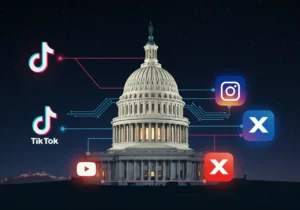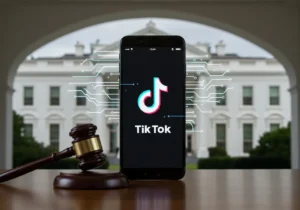The White House has confirmed an agreement that would place TikTok’s powerful recommendation system under U.S. oversight. The deal, which restructures TikTok’s U.S. operations, is designed to address long-standing concerns about foreign influence, data privacy, and national security. With six of seven board seats held by Americans and data oversight by U.S. companies, this marks a turning point in the global regulation of social media platforms. (Associated Press)
Details of the TikTok Deal
According to White House press statements, the agreement includes:
- Algorithm control: The U.S. entity will oversee TikTok’s recommendation system, which shapes what users see in their feeds.
- Board restructuring: Six of seven seats will be held by Americans to ensure U.S. interests dominate decision-making. (Barron’s)
- Data oversight: American companies such as Oracle will likely host and monitor TikTok’s U.S. data infrastructure.
This deal aims to resolve years of bipartisan concern in Washington that TikTok, owned by ByteDance in China, could be misused for surveillance or propaganda.
Why Algorithm Oversight Matters
 Algorithms determine what goes viral, which creators succeed, and how information flows. By gaining oversight of TikTok’s algorithm, U.S. regulators hope to:
Algorithms determine what goes viral, which creators succeed, and how information flows. By gaining oversight of TikTok’s algorithm, U.S. regulators hope to:
- Prevent foreign influence in trending content or political narratives.
- Strengthen data security by ensuring user data remains within U.S. legal frameworks.
- Improve transparency about how recommendations are generated.
- Reduce fears of algorithmic bias driven by foreign interests.
Implications for Creators
Creators—who depend on TikTok for income, visibility, and audience growth—may see direct impacts:
- Content discovery: Changes in how videos are recommended could affect what niches thrive or fade.
- Monetization shifts: New U.S. oversight may prioritize transparency, but could also alter creator fund payouts or partnership opportunities.
- Greater stability: With political uncertainty reduced, creators may feel safer investing in TikTok growth strategies.
- Regulation risks: U.S. officials may impose stricter moderation standards, which could limit edgy or controversial content.
How Users Could Be Affected
For everyday TikTok users, oversight may mean:
- Stronger data protections and possibly clearer privacy policies.
- Shifts in the type of content promoted, as U.S. cultural and political standards influence moderation.
- Potentially more transparent controls for managing what appears in feeds.
Criticism and Concerns
While many welcome the deal, critics warn of challenges:
- Freedom of expression: Some worry U.S. oversight could introduce political bias in moderation.
- Technical hurdles: Separating U.S. and international operations of a global app may be costly and complex.
- International backlash: China may resist losing control over TikTok’s core technology, sparking trade tensions. (Financial Times)
How Other Countries Are Responding
The U.S. move is being closely watched worldwide. Europe’s Digital Services Act already demands more transparency in algorithmic recommendations, and other countries may follow suit with their own oversight rules. This deal may set a precedent for how governments regulate foreign-owned platforms.
What Brands and Marketers Should Do
For brands and influencers, preparing for algorithm shifts is critical:
- Diversify presence across multiple platforms to reduce dependency on TikTok alone.
- Track analytics closely to detect performance changes after the oversight takes effect.
- Invest in authentic engagement—content with genuine interactions is more likely to survive algorithm adjustments.
- Stay updated on U.S. policy announcements that could affect content distribution.
Bigger Picture: The Future of Social Media Oversight
 The TikTok deal reflects a growing trend: governments taking active roles in shaping digital platforms. From privacy protections to misinformation controls, algorithmic oversight is becoming a policy priority. For TikTok, U.S. control of the algorithm is both a safeguard and a test case for how far governments can intervene in global tech platforms.
The TikTok deal reflects a growing trend: governments taking active roles in shaping digital platforms. From privacy protections to misinformation controls, algorithmic oversight is becoming a policy priority. For TikTok, U.S. control of the algorithm is both a safeguard and a test case for how far governments can intervene in global tech platforms.
Conclusion
The U.S. gaining oversight of TikTok’s algorithm is a landmark in the regulation of social media. For users, it could mean greater security and transparency. For creators, it introduces both opportunities and challenges. For policymakers, it sets a precedent in balancing national security with free expression. As details unfold, one thing is clear: the algorithm is no longer just a technical tool—it is a matter of national policy and global influence.
Stay tuned to OnlineMediaPage.com for continuing coverage on TikTok, algorithm regulation, and the future of media policy.





